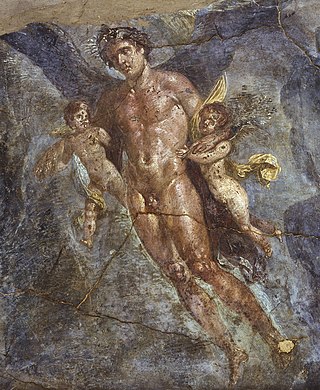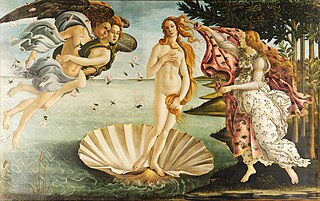| The winds of the Mediterranean |
|---|
A west wind is a wind that originates in the west and blows in an eastward direction.
| The winds of the Mediterranean |
|---|
A west wind is a wind that originates in the west and blows in an eastward direction.
In European tradition, it has usually been considered the mildest and most favorable of the directional winds.
In Greek mythology, Zephyrus was the personification of the west wind and the bringer of light spring and early summer breezes; his Roman equivalent was Favonius (hence the adjective favonian, pertaining to the west wind).
In Egyptian mythology, Ḥutchai is the god of the west wind. He was depicted as a man with the head of a serpent.
Geoffrey Chaucer wrote of the "swete breth" of Zephyrus, and a soft, gentle breeze may be referred to as a zephyr, as in William Shakespeare's Cymbeline (IV, ii): "They are as gentle / As zephyrs blowing below the violet, / Not wagging his sweet head."
In Iroquois tradition, the "west wind" is brought by the Panther, ugly and fierce.
In Italian history, Ponente is the west wind and the personification of spring and early summer; his winds are usually calm and lukewarm and very gentle. His ancient Roman equivalent is Favonius.[ citation needed ]
West winds are inhabited by spirits or Jīvas called vāyukāya ekendriya according to Jainism. [1]

In Greek mythology and religion, Notus is the god of the south wind and one of the Anemoi (wind-gods), sons of the dawn goddess Eos and the star-god Astraeus. A desiccating, hot wind of heat, Notus was associated with the storms of late summer and early autumn, wetness, mist, and was seen as a rain-bringer. Unlike his two more notable brothers, Boreas and Zephyrus, Notus has little to no unique mythology of his own.

In Greek mythology and religion, Zephyrus, also spelled in English as Zephyr, is the god and personification of the West wind, one of the several wind gods, the Anemoi. The son of Eos, the goddess of the dawn, and Astraeus, Zephyrus is the most gentle and favourable of the winds, and is also associated with flowers, springtime and even procreation. In myths, he is presented as the tender breeze, and he is known for his unrequited love for the Spartan prince Hyacinthus. Although he along with Boreas are the two most prominent wind gods, their role in mythology is relatively limited.

In Greek mythology and religion, Eurus is the god and personification of the east wind, although sometimes he is also said to be southeast specifically. He is one of the four principal wind gods, the Anemoi, alongside Boreas, Zephyrus and Notus. Eurus is featured rarely in ancient literature, appearing together with his three brothers as part of a whole if at all, and virtually has no individual mythology of his own. Often he is excluded entirely, leaving Boreas, Zephyrus and Notus to represent the Anemoi. His Roman equivalent is the god Vulturnus.

The Birth of Venus is a painting by the Italian artist Sandro Botticelli, probably executed in the mid 1480s. It depicts the goddess Venus arriving at the shore after her birth, when she had emerged from the sea fully-grown. The painting is in the Uffizi Gallery in Florence, Italy.
In European tradition, a zephyr is a light wind or a west wind, named after Zephyrus, the Greek god or personification of the west wind.

Flora is a Roman goddess of flowers and spring – a symbol for nature and flowers. While she was otherwise a relatively minor figure in Roman mythology, being one among several fertility goddesses, her association with the spring gave her particular importance at the coming of springtime, as did her role as goddess of youth. She was one of the fifteen deities who had their own flamen, the Floralis, one of the flamines minores. Her Greek counterpart is Chloris.

The Fremantle Doctor, the Freo Doctor, or simply The Doctor, is the Western Australian vernacular term for the cooling afternoon sea breeze that occurs during summer months in south west coastal areas of Western Australia. The sea breeze occurs because of the major temperature difference between the land and sea.

In ancient Greek religion and myth, the Anemoi were wind gods who were each ascribed a cardinal direction from which their respective winds came, and were each associated with various seasons and weather conditions. They were the progeny of the goddess of the dawn Eos and her husband, the god of the dusk, Astraeus.
A south wind is a wind that originates in the south and blows in a northward direction.
Marcus Favonius was a Roman politician during the period of the fall of the Roman Republic. He is noted for his imitation of Cato the Younger, his espousal of the Cynic philosophy, and for his appearance as the Poet in William Shakespeare's play Julius Caesar.

Primavera, is a large panel painting in tempera paint by the Italian Renaissance painter Sandro Botticelli made in the late 1470s or early 1480s. It has been described as "one of the most written about, and most controversial paintings in the world", and also "one of the most popular paintings in Western art".

In the ancient Mediterranean world, the classical compass winds were names for the points of geographic direction and orientation, in association with the winds as conceived of by the ancient Greeks and Romans. Ancient wind roses typically had twelve winds and thus twelve points of orientation, sometimes reduced to eight or increased to twenty-four.

Favonius (1868–1877) was a British Thoroughbred racehorse and sire. In a career that lasted from 1871 to 1873, he ran ten times and won five races. In June 1871 he won The Derby on his second racecourse appearance. He went on to prove himself a top class stayer, winning the Goodwood Cup in 1872. Favonius was regarded by contemporary observers as one of the best English-trained horses of his era. At the end of the 1873 season he was retired to stud but had little chance to make an impact as a stallion before his death four years later. Favonius’s Derby win was one of the highlights of what became known as “The Baron’s Year”, in which his owner, Baron Meyer de Rothschild won four of the five British Classic Races.

There are a number of deities and personifications associated with seasons in various mythologies, traditions, and fiction.
The gens Favonia was a plebeian family at Rome. It is known chiefly from three individuals, one of whom, Marcus Favonius was a politician during the period of the fall of the Roman Republic.
The Ṣabā is an east wind that blows in the west of the Arabian peninsula. Because of its gentleness (riqqa) and pleasant breeze, it was especially popular among the Arabs, and was called "Wind of the lovers" (rīḥ al-ʿuššāq). The Ṣabā was considered the wind that gathers the clouds and brings rain and, unlike the west and south winds, does not cause dryness (haif). The Arabs living in the Desert are said to have set up their tents in a way that they could capture the Ṣabā with their openings. In classical Arabic lyrical poetry, the wind is highly praised and plays a role similar to the Zephyrus of the Greco-Roman world. Since there is a canonical Hadith stating that Muhammad is said to have enjoyed the support of the Ṣabā wind, it holds religious significance in Islam as well. In Arabic-Islamic meteorology, the term "Ṣabā" later became a general term, independent of its local occurrence, to refer to the east wind which, alongside the north wind (šimāl), south wind (janūb), and west wind (dabūr), constitutes one of the four cardinal winds of the wind rose.

Flora Caressed by Zephyr, also titled Dawn (L'Aurore), is an 1802 oil painting by François Gérard which depicts the love of Flora (Spring) and Zephyr from Graeco-Roman mythology.